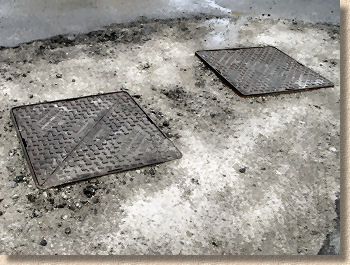Key Indicators:
The first step when planning to fix additional drainage points to an existing system is to identify the type of system: is it a dual system with separate foul and surface water pipelines, or is it a combined system, where foul and surface water are mixed together and carried in the same pipes?
There are a few basic pointers that can be used to aid identification.
1 - Age of property
Most modern properties (1970 or later) tend to have DUAL systems, but this must be verified.

2 - Number and layout of manhole covers
DUAL systems tend to have more manhole covers (often a source of irritation to householders) and there are sometimes two covers side-by-side.
3 - Presence of sewage in chamber
If there is obvious sewage in a chamber when the cover is lifted, then it must be a FOUL or a COMBINED system. Toilet tissue is often visible stuck to the benching or the channels within inspection chambers and manholes.
4 - Depth to invert
In DUAL systems, the foul should always be deeper than the surface water. This is a safety precaution in case of a breakage to the foul system, which, if it were to be the shallower of the two, could percolate down and contaminate the surface system.
Checking the system:
While the pointers listed above can aid in preliminary identification of a sewer system, the actual classification of a drain must be verified as outlined below before installing any additional drainage.....
1 - Lift cover and check layout of drainage within chamber
2 - try to identify fittings that are likely to be connected to the chamber under inspection. These must be upstream of the chamber, and may be rain water pick-ups, kitchen waste gullies, toilet stacks, linear drains etc.
3 - put a garden hose into the fittings and see if the water appears in the chamber. For indoor fittings, such as baths, wash-basins or toilets, try turning on a tap or flushing the cistern. If in doubt, a drain-tracing dye (available for a couple of quid at most Builders' Merchants) can be added, turning the water a distinctive colour that will be readily identified if it passes through the chamber under inspection.
- In a COMBINED system, the test water is observed in the chamber from both foul and surface sources.
- In a SURFACE system, the test water will only be observed when added to a surface drainage point
- In a FOUL system, the test water will be observed when the toilet is flushed
- If in doubt, use trapped fittings.
Surface Sources
- - Rainwater pickups (Downspouts)
- - Yard or Road Gullies
- - Linear drains
Foul Sources
- - Kitchen waste
- - Toilet/Soil and Vent Pipe
- - Bath/Shower/Bidet
- - Any industrial process
Soakaways:
Some properties may have the surface water drained to a soakaway , the older of which are notorious for silting-up and causing water-logging problems. If a large area of paving (50m² or more) is to be drained into a soakaway, its efficacy should be tested first by putting a garden hose on medium flow into one of the feeder gullies for 2-4 hours. If the soakaway cannot cope with the inflow, it may need to be rebuilt, or a new soakaway may need to be constructed at a distance of at least 20m from the existing one.
SUDS Pages
